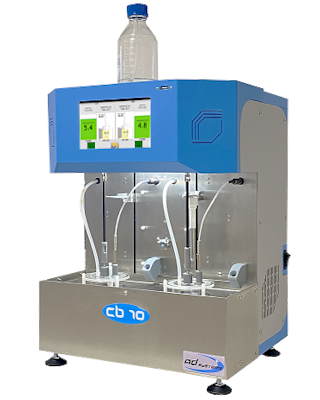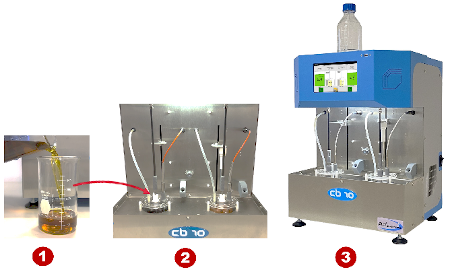CB10
ASTM / NACE Corrosion Bath
ASTM D665, D4378, NACE TM0172,
IP 135, ISO 7120, GOST 19199, JIS K2510

The CB10 revolutionizes corrosion testing by bringing unmatched automation and precision to the analysis of corrosion properties of mineral oils and pipeline cargoes.
The test preparation is simplified and the test can be run unattended simultaneously or independently on the two positions. Test timing, water injection volume, temperature and specimen insertion are precisely controlled.
Directly compatible with both ASTM & NACE test methods, the CB10 strictly follows the selected test method (ASTM D665, NACE TM0172, ASTM D7577, GOST 19199, JIS K2510, …).
The corrosion rating can be done visually (pass/fail) or much more precise and not subjective by automated corrosion rater CT10.
Refineries
Mineral and steam turbine oils
Pipeline and terminals
Iron Corrosion testing
ASTM D665 (A, B, C)
ASTM D4378, D7155, D7577
NACE TM0172
IP 135, IP PM DB
ISO 7120
GOST 19199
JIS K2510
Easy
The CB10 is a straightfoward fully automated instrument. The test preparation is simplified and the test can be run unattended, independently, on the 2 positions.
Wide range of applications
The CB10 is directly compatible with the following types of sample : lubricating oils, pipeline cargoes and glycol.
Increased precision
Both PT100s come with embedded calibration data. The instrument precisely controls all the test conditions : temperature, stirring speed, time, water volume injection.
Reduced labor and operation time
The test preparation is simplified and the test is run automatically and independently on the two positions.
Increased safety
The CB10 totally eliminates all safety risks. If anything hangs to the stirrer shaft, the stirring will be stopped to prevent injuries.
Very compact design
The 2 positions standalone automated CB10 instrument does not need much bench space: the width is only 44 cm.
Running a test with the CB10 is straightforward and very easy. The operator just has to:
- pour the sample into the beaker
- install the beaker and test specimen on the CB10
- initiate the test
The entire procedure is automated: heating, stirring, insertion of test specimen, water injection.
Test Procedure (ASTM D665): A 300ml of oil sample is heated with a stirring at 60°C . A steel rod (spindle) is immersed into the sample and 30 ml of water is added. Depends on the specification the test duration can be up to 24 hours. The 10% water addition can be either distilled water (ASTM D 665 A) or synthetic sea water (ASTM D 665 B). Due to its severity, the synthetic sea water test procedure (B) is frequently used as a screening test. The test is normally run in duplicate and any visible rust on both rods indicates failure.
At the end of the test, the CB10 automatically lifts the test specimen in order to proceed with the rating. The rating can be manual (pass/fail) or more precise and not subjective by automated corrosion rater CT10.
Corrosion rating can be done visually by a trained operator.

| Technical Points | Description |
| Temperature | Ambient to 80°C +/-1°C (programmable) |
| PT100 | Embedded calibration data |
| Stirring | Up to 2000 rpm +/- 50 rpm (programmable) |
| Water volume injection | Up to 50 ml |
| Water reserve | Capacity: 1L |
| Interface | 7'' full-color capacitive touch screen |
| Languages | English, French |
| Communication | USB (2), Ethernet (1) |
| Dimensions | W x D x H (mm): 440 x 415 x 630 W x D x H (inches): 17" x 16" x 25" |
| Weight | 22 kg (49 lbs) |
| Electrical | 100/240V - 50/60Hz - 500W |
| Operating conditions | Temperature: from +10°C to +35°C RH: 20% to 90% non-condensing |
Mineral oil
Lubricant oil
Pipeline cargoes (Gasoline, Diesel, ...)
Glycol applications
Denathorated Ethanol and Ethanol Fuel blends
